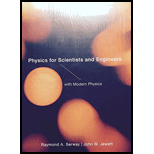
Concept explainers
(a)
The acceleration of the block on sliding.
(a)
Answer to Problem 101CP
The acceleration of the block is
Explanation of Solution
Write the expression to calculate the acceleration of the block along an inclined plane.
Here, a is the acceleration of the block, g is the acceleration due to gravity and
Conclusion:
Substitute
Therefore, the acceleration of the block is
(b)
The velocity of the block after it leaves the plane.
(b)
Answer to Problem 101CP
The velocity of the block is
Explanation of Solution
Refer the equation (IV).
Write the expression to calculate the length of the inclined plane.
Here, x is the length of inclined plane and h is the height of the inclined surface from the table.
Write the expression to calculate the velocity of the block.
Here, v is the final velocity and u is the initial velocity.
Conclusion:
Substitute
Substitute
Therefore, the velocity of the block is
(c)
The distance from the table to the block when the later hits the floor.
(c)
Answer to Problem 101CP
The distance from the table is
Explanation of Solution
Refer the equation (IV).
Write the expression to calculate the vertical displacement.
Here, V is initial vertical velocity and t is the time taken to reach the ground.
Write the expression to calculate the vertical velocity of the block.
Use the equation (IV) to rewrite the equation (III).
Write the expression to calculate the distance of the block from the table.
Here, x is the distance from the table.
Conclusion:
Substitute
Solve the above quadratic equation to find t.
Only positive root considered for the time t.
Substitute
Therefore, the distance from the table is
(d)
The time interval between the releasing of the block and hitting the floor.
(d)
Answer to Problem 101CP
The time interval between the given events is
Explanation of Solution
Writ the time required to reach the block to the bottom of the inclined plane.
Here,
Write the expression to calculate the time interval between the given events.
Here, T is the time interval.
Rewrite the above equation using the expression for
Conclusion:
Substitute
Therefore, the time interval between the given events is
(e)
Did the mass affect any of the calculation given above.
(e)
Answer to Problem 101CP
The mass of the block does not have any role on the calculation.
Explanation of Solution
In this case, the mass is moving along a frictionless inclined plane and therefore, there were no effect of mass for the mechanical calculations regarding the motion of the block.
The motion of the block is depends on the acceleration due to gravity as in the same case for an object under free fall.
Thus, the magnitude of mass of an object moving along a frictionless plane has no role in the mechanical calculations.
Conclusion:
Substitute
Therefore, the mass of the block does not have any role on the calculation.
Want to see more full solutions like this?
Chapter 5 Solutions
Physics For Scientists And Engineers With Modern Physics, 9th Edition, The Ohio State University
- No chatgpt plsarrow_forwardhelp me with the experimental set up for the excel i did. the grapharrow_forwardWhich of the following best describes how to calculate the average acceleration of any object? Average acceleration is always halfway between the initial acceleration of an object and its final acceleration. Average acceleration is always equal to the change in velocity of an object divided by the time interval. Average acceleration is always equal to the displacement of an object divided by the time interval. Average acceleration is always equal to the change in speed of an object divided by the time interval.arrow_forward
- The figure shows the velocity versus time graph for a car driving on a straight road. Which of the following best describes the acceleration of the car? v (m/s) t(s) The acceleration of the car is negative and decreasing. The acceleration of the car is constant. The acceleration of the car is positive and increasing. The acceleration of the car is positive and decreasing. The acceleration of the car is negative and increasing.arrow_forwardWhich figure could represent the velocity versus time graph of a motorcycle whose speed is increasing? v (m/s) v (m/s) t(s) t(s)arrow_forwardUnlike speed, velocity is a the statement? Poisition. Direction. Vector. Scalar. quantity. Which one of the following completesarrow_forward
- No chatgpt pls will upvote Already got wrong chatgpt answerarrow_forward3.63 • Leaping the River II. A physics professor did daredevil stunts in his spare time. His last stunt was an attempt to jump across a river on a motorcycle (Fig. P3.63). The takeoff ramp was inclined at 53.0°, the river was 40.0 m wide, and the far bank was 15.0 m lower than the top of the ramp. The river itself was 100 m below the ramp. Ignore air resistance. (a) What should his speed have been at the top of the ramp to have just made it to the edge of the far bank? (b) If his speed was only half the value found in part (a), where did he land? Figure P3.63 53.0° 100 m 40.0 m→ 15.0 marrow_forwardPlease solve and answer the question correctly please. Thank you!!arrow_forward
 Glencoe Physics: Principles and Problems, Student...PhysicsISBN:9780078807213Author:Paul W. ZitzewitzPublisher:Glencoe/McGraw-Hill
Glencoe Physics: Principles and Problems, Student...PhysicsISBN:9780078807213Author:Paul W. ZitzewitzPublisher:Glencoe/McGraw-Hill Physics for Scientists and Engineers: Foundations...PhysicsISBN:9781133939146Author:Katz, Debora M.Publisher:Cengage Learning
Physics for Scientists and Engineers: Foundations...PhysicsISBN:9781133939146Author:Katz, Debora M.Publisher:Cengage Learning Physics for Scientists and Engineers with Modern ...PhysicsISBN:9781337553292Author:Raymond A. Serway, John W. JewettPublisher:Cengage Learning
Physics for Scientists and Engineers with Modern ...PhysicsISBN:9781337553292Author:Raymond A. Serway, John W. JewettPublisher:Cengage Learning Physics for Scientists and EngineersPhysicsISBN:9781337553278Author:Raymond A. Serway, John W. JewettPublisher:Cengage Learning
Physics for Scientists and EngineersPhysicsISBN:9781337553278Author:Raymond A. Serway, John W. JewettPublisher:Cengage Learning Principles of Physics: A Calculus-Based TextPhysicsISBN:9781133104261Author:Raymond A. Serway, John W. JewettPublisher:Cengage Learning
Principles of Physics: A Calculus-Based TextPhysicsISBN:9781133104261Author:Raymond A. Serway, John W. JewettPublisher:Cengage Learning Physics for Scientists and Engineers, Technology ...PhysicsISBN:9781305116399Author:Raymond A. Serway, John W. JewettPublisher:Cengage Learning
Physics for Scientists and Engineers, Technology ...PhysicsISBN:9781305116399Author:Raymond A. Serway, John W. JewettPublisher:Cengage Learning





